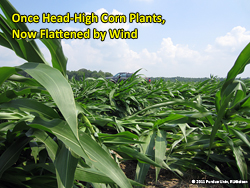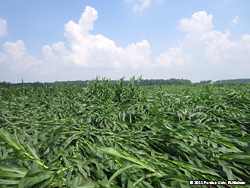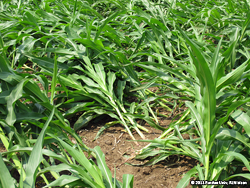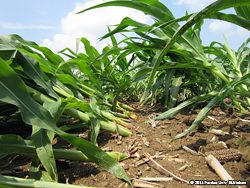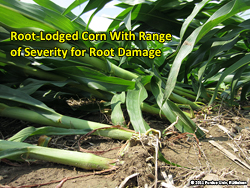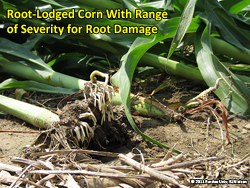26 July 2011
URL: http://www.kingcorn.org/news/articles.11/FlatCorn-0726.html
Prospects of Recovery for Root-Lodged Corn
R.L. (Bob) Nielsen
Agronomy Dept., Purdue Univ.
West Lafayette, IN 47907-2054
Email address: rnielsen
at purdue.edu
![]() cattered storms across Indiana in the past week or so flattened hundreds, if not thousands, of acres of corn. In contrast to stalk breakage, these flattened fields are the result of corn stalks being partially uprooted by strong winds and literally laid flat to the ground. Thus, the technical term for such flattening is "root lodging", not "stalk lodging".
cattered storms across Indiana in the past week or so flattened hundreds, if not thousands, of acres of corn. In contrast to stalk breakage, these flattened fields are the result of corn stalks being partially uprooted by strong winds and literally laid flat to the ground. Thus, the technical term for such flattening is "root lodging", not "stalk lodging".
The severity of the root lodging varies among and within fields, depending on the severity of the winds and the amount of soil saturation that accompanied the winds. The severity of root lodging was also influenced by the relative rooting depth of a field or area within a field. This growing season has not been conducive for deep rooting primarily because of shallow soil compaction created by pre-planting tillage operations and during the planting process itself. Soggy soils in the weeks after planting were not conducive for deep rooting. Excessively dry surface soils in recent weeks, coupled with shallow soil compaction layers, have not been conducive for further root development. Hybrids themselves vary naturally for root development and, thus, for susceptibility to root lodging.
Even though the natural response after walking a flattened field of corn is to assume catastrophic yield loss, there is an opportunity for such damaged fields to partially recover depending on the growth stage at which the damage occurred and the degree of root damage.
Others have speculated on the range of yield losses that may occur from flattened corn (see Related Reading below). Generally speaking, the younger the growth stage, the greater the opportunity for partial or perhaps even full recovery from such root lodging. The severity of root damage also influences the degree of recovery from root lodging.
Stage of Growth
Late-planted fields that are 1 to 2 weeks away from tasseling have the capacity to respond to the flattening because their stalks are still elongating. The upper stalks of these nearly horizontal plants will bend or "goose-neck" as stalk elongation continues. With time, damaged fields may appear to have fully straightened up when in fact the lower stalks are still leaning severely. However, the good news with this type of "recovery" is that later-occurring pollination may be fairly successful if both tassels and silked ears are "lifted up" by the "goose-necking" of the elongating stalks.
Earlier-planted fields already pollinating or beyond when flattened simply do not have as much capacity to straighten up or "goose-neck" because stalk elongation is essentially complete by tasseling. Fields that were beginning or within days of beginning to pollinate are particularly susceptible to yield loss when the field is flattened by wind because both tassels and silks are not only near to the ground but also partially covered by the leaves of neighboring plants also laying flat. Pollen is not shed properly, silks are not exposed properly to pollen, and kernel set will subsequently range from zero to poor.
Fields that were already beyond pollination and into early stages of grain filling when the wind damage occurred suffer the same inability to straighten up significantly after a flattening event. Photosynthesis will be severely curtailed within the flattened canopy because of the significant shading of plants by other plants. Kernel abortion in such flattened fields could be significant.
Extent of Root Damage
The other factor that influences the degree of recovery from such flattening events is the extent of root damage suffered by the individual plants. Less root damage means more opportunity to recover and vice versa. The ability for compensatory root development is also influenced by whether soil moisture is adequate or not. Thankfully, many of the damaging storms also dropped 2+ inches of much-needed rain. Nevertheless, the root regeneration ability of damaged plants will play a role in determining the impact of the flattening event.
Other Complications
There is some concern that flattened corn will be more susceptible to foliar disease because of the proximity to the soil surface and possible higher humidity levels within the flattened canopy. Alison Robertson, Iowa State University, addresses the question of whether flattened fields should be sprayed with foliar fungicides in her recent article. My take on her comments is that benefits to such fungicide applications are NOT assured.
Let's say you are lucky and your flattened fields straighten up enough to successfully pollinate. Then let's say that grain filling occurs without a hitch and ear size is acceptable. Now think about those "goose-necked" lower portions of the stalk and how they relate to the center of gravity created by those acceptable ear sizes situated higher up the stalk. If stalk rots or simply stalk cannibalization develop late in the grain filling process, those "goose-necked" plants will likely be at greater risk of stalk breakage prior to harvest.
A final consequence of "goose-necked" fields will be the increased challenges of grain harvest. First of all, it may be difficult to harvest "on the rows" because the "rows" you will see from the combine cab will be the tops of "goose-necked" plants. That headache plus the possible greater risk of stalk breakage noted earlier will easily translate into a frustratingly slow harvest. Growers may want to consider arranging for combine reels or similar header attachments to aid in gathering downed corn into the header.
Related Reading
Elmore, Roger. 2011. Wind and Corn. Integrated Crop Management News, Iowa State Univ Extension. [online] Available at http://www.extension.iastate.edu/CropNews/2011/0712elmore.htm [URL accessed July 2011].
Lauer, Joe. 2011. Yield Response of Flattened (Lodged) Corn. Agronomy Advice, Univ of Wisconsin Extension [online] Available at http://corn.agronomy.wisc.edu/AA/A086.aspx [URL accessed July 2011].
Nafziger, Emerson. 2011. Wind Damage in Corn. The Bulletin, Univ of Illinois Extension. [online] Available at http://bulletin.ipm.illinois.edu/article.php?id=1534 [URL accessed July 2011].
Robertson, Alison. 2011. Thoughts on Spraying Downed Corn with a Fungicide. Integrated Crop Management News, Iowa State Univ Extension. [online] Available at http://www.extension.iastate.edu/CropNews/2011/0713robertsona.htm [URL accessed July 2011].
Thomison, Peter. 2011. Effects of Wind Lodging on Corn Performance. C.O.R.N., Ohio State Univ Extension. [online] Available at http://corn.osu.edu/newsletters/2011/2011-22/effects-of-wind-lodging-on-corn-performance [URL accessed July 2011].

